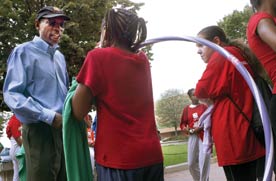
Technician Stacie Eliades works in the IdentiGEN lab in Lawrence, Kansas.
Senators Obama and McCain have each proposed helping more Americans achieve the “American Dream.” But few voters may realize that the candidates’ vision of that dream may itself exclude millions of Americans from a better life.
Housing advocates recognize this dilemma when a politician equates the American Dream with homeownership. Advocates agree that homeownership should be more equitably available. But they also know that when a third of U.S. households rent, a housing policy focused solely on ownership can put disproportionate resources toward that one goal (see our tax code) while doing little for millions who would have benefited from a comparable investment in affordable rental housing. And as we’ve seen in the foreclosure crisis, a focus on the homeownership dream, coupled with limited viable rental options, will push some individuals to take on tremendous debt for a home they ultimately cannot afford.
Workforce-development advocates face a similar dilemma. In addressing education and economic opportunity, both parties invoke the American Dream when proposing to help more children get a four-year college degree. “College for all” was the rallying cry for Congress’ recent Pell Grant expansion and student loan interest-rate reductions — initiatives that leveraged billions of needed federal dollars. Workforce advocates fought for these reforms because we believe that any young person who wants to should be able to go to college. But we also know that a workforce policy focused solely on college for kids bypasses the majority of Americans who are not college-bound, but who still need investments in their skills to succeed.
Most college-educated policymakers don’t realize that their own educational pathway — from high school to full-time college to professional degree — is not the typical route to skilled employment. Fewer than one in three U.S. workers has earned a four-year degree, and only a portion did it as a full-time student. In fact, most college students today, particularly at community colleges, are working adults.
Policymakers are equally surprised to learn that the majority of skilled jobs in today’s economy don’t require a four-year degree. According to a recent study for The Workforce Alliance by Harry Holzer and Bob Lerman, only a third of job openings over the next 10 years will require a BA/BS, while nearly half will require up to two years of technical education and training past high school. The national Skills2Compete campaign has called these America’s “forgotten middle-skill jobs.” They are nurses, welders, lab technicians, computer-savvy manufacturing workers — occupations with deepening shortages of skilled workers. Many of these jobs pay well, cannot be shipped overseas, and offer immediate pathways out of poverty.
Yet we continue to hear that a four-year degree is the only legitimate course to success. As a result, just as we’ve seen with home foreclosures, many Americans of even limited means see no alternative but to incur tremendous debt in pursuit of an expensive university degree which they may never finish, or which might not even qualify them for the better-paying jobs in their communities.
What could the next president do? First, call for immediate action on specific proposals sitting before Congress that are not getting the same attention as traditional college access initiatives. These include: new investments in training for middle-skill jobs, developed by local industry partnerships jointly led by business, labor, training providers, and the public workforce system; vastly expanded adult basic skills and language education delivered in concert with occupational training at community-based organizations or community colleges; a new national apprenticeship system developed in collaboration with unions and the skilled trades; and new financial aid grants and refundable tax credits for working adults who want to attend college part-time.
To advance such policy changes, however, will require the next president to first more publicly champion a new education dream that will truly benefit all Americans. Seventy years ago, President Roosevelt responded to an industrializing economy by guaranteeing everyone a high-school education. But that broad-based 20th-century skill guarantee is long overdue for an update. In the 21st century, President Obama or McCain could guarantee every U.S. worker access to the skills necessary for a good-paying middle-skill job, or the first two years of college — recognizing that most who finish a degree will do so while working.
A two-year skills guarantee past high school for all, in concert with greater equity in full-time four-year degrees, would truly make the American Dream a reality for more Americans.





I find it interesting that the photo of this article is of a four year college graduate.
Many of us don’t know about this event. Your post is helpful in this case. it will help people know about such nobel events and will create awareness. club penguin cheats